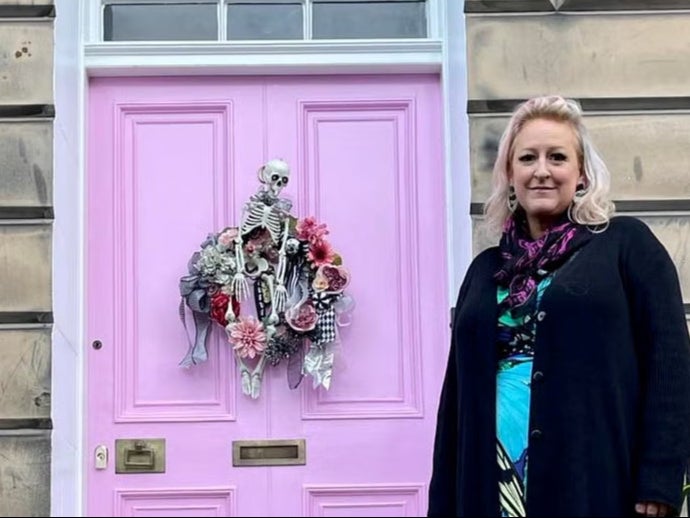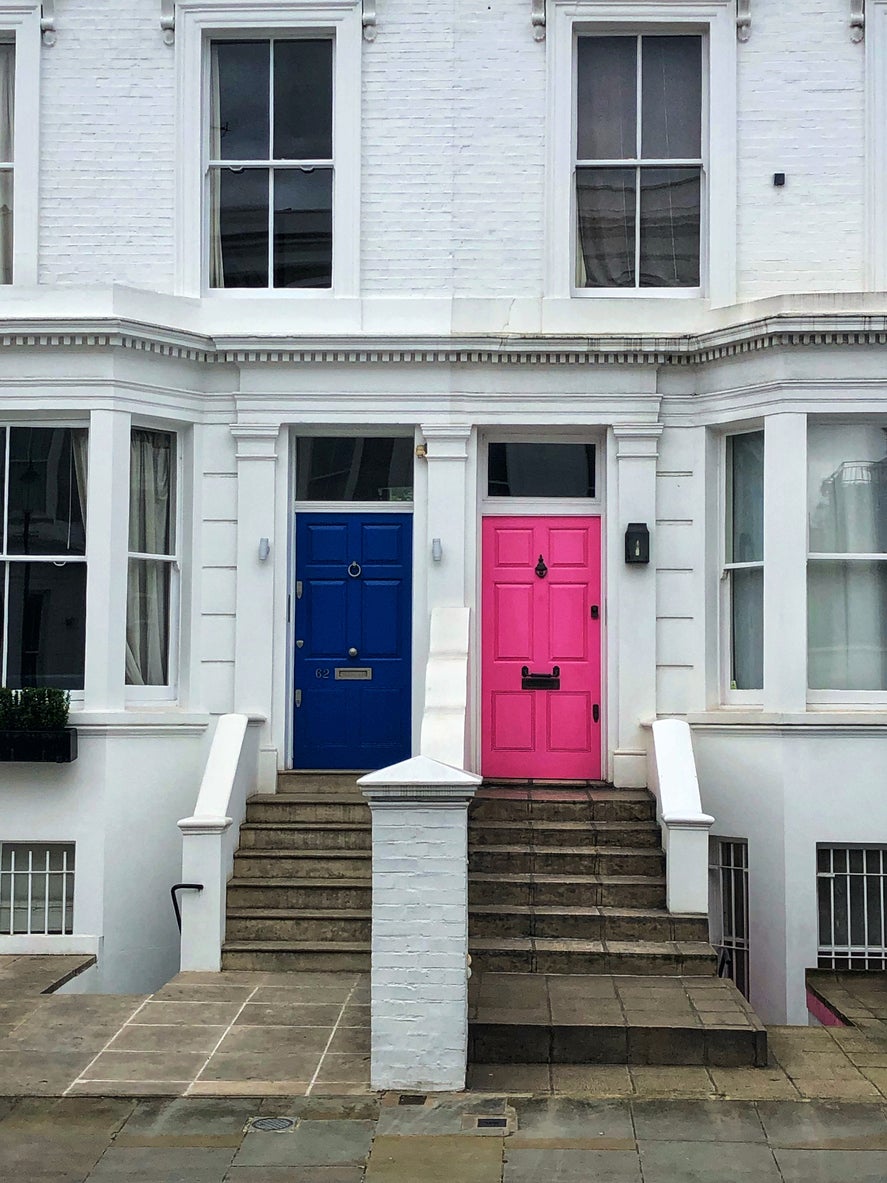Who cares if I paint my front door bright pink?
The neighbours can get upset if your choice is too eye-catching, but what’s the etiquette, in and out of conservation areas? Marie-Claire Chappet talks to some of those who prefer a zesty entrance

Your support helps us to tell the story
From reproductive rights to climate change to Big Tech, The Independent is on the ground when the story is developing. Whether it's investigating the financials of Elon Musk's pro-Trump PAC or producing our latest documentary, 'The A Word', which shines a light on the American women fighting for reproductive rights, we know how important it is to parse out the facts from the messaging.
At such a critical moment in US history, we need reporters on the ground. Your donation allows us to keep sending journalists to speak to both sides of the story.
The Independent is trusted by Americans across the entire political spectrum. And unlike many other quality news outlets, we choose not to lock Americans out of our reporting and analysis with paywalls. We believe quality journalism should be available to everyone, paid for by those who can afford it.
Your support makes all the difference.A year ago, friends of mine bought a wonderful Victorian house in north London after a stressful, drawn-out property search. There was just one immediate problem: it had a bright yellow door.
“It’s not a nice yellow, like a pale or mustard yellow, it’s like... a toxic yellow,” my friend told me. Her husband agreed.
“We call it The Bad Yellow Door House,” he muttered. “That must be what the neighbours call it.”
If I’m honest, it was a Bad Yellow Door. And, given the area (v Gail’s, one might say) I’m fairly certain it provoked a few disgruntled comments from the neighbourhood, or at least a few snarky threads on the Nextdoor app.
Thankfully, there was no reason to believe that disquiet could reach the pitch of the scandal surrounding poor Miranda Dickson, aka The Pink Door Lady. She painted the entrance to her Edinburgh home in a rose hue, which led to complaints and a council enforcement notice last year. Dickson was told she would have to paint the door white or apply for planning permission despite the chief planning officer telling her to stick to the traditional shades of dark red, dark grey, sage green, dark blue or black.
Following a spell as a green door (the shade of which was rejected by the planning committee), the entryway was repainted as instructed by Dickson, but Edinburgh council has now received a complaint that the door is back to pink. Dickson has previously faced a £20,000 fine if she didn’t change the colour and it seems she is once again in the firing line for her misuse of the term “off white”.
While the case is ongoing, it got me thinking: is there really such a thing as a “too colourful” front door?
“Not at all,” says Andrew Groocock, regional partner at estate agents Knight Frank, “in fact, my own front door is pink!” Groocock even believes it could be a selling point for your property. “I am a massive believer that the door to a house is one of the most important things that you can pay attention to when you’re coming to sell, or even buy a property. As long as it is freshly painted, clean and tidy, I don’t personally think that there’s any colour that’s too much.”

Of course, not everyone shares Groocock’s live-and-let-paint attitude.
“I so desperately want to go with Farrow & Ball’s ‘Arsenic’, but my neighbour opposite has it already and it did not go down well with the road,” says Caroline, a PR executive from London. “I’m worried – I read that story about the woman with the pink door!” she adds, laughing, as though she has dodged a bullet.
Alison, an accountant from Surrey, though, has already done the unthinkable: “I painted mine bright pink and I am getting nice black and white flooring done outside but my neighbour sent me an email saying, ‘Why have you done this?’” She continues: “It was always my dream, when I owned a property, to paint the front door pink. The shade is from Little Greene and it is called ‘Leather’ and it is admittedly a super punchy pink, but I catch people taking photos of it all the time so I think it is bringing people joy?”
Just not your neighbour? “Oh no, she hates it,” says Alison. “She admitted it doesn’t actually affect her, she just told me she thinks it is wrong because all doors should be grey.”
A sunshine yellow door like ‘Babouche’ always shouts a great big hello and welcome
If all doors should be grey, then I wonder why such evocative paint shades exist. Or is the proof in the name? “Arsenic” will poison your relationship with your neighbours? “Leather” will go down like a BDSM party in the vicarage? I decide to ask the source of all middle-class paint dreams: Farrow & Ball.
When it comes to door colours, a brand spokesperson tells me, “while soft whites are a classic, it is darks that rule the roost”. But even Farrow & Ball, it seems, are not against more zesty options.
“A sunshine yellow door like ‘Babouche’ always shouts a great big hello and welcome and we are also seeing some sultry pinks making an appearance, it’s about personality and introduction!” the spokesperson says. “There is no such thing as the ideal shade – I’ve seen bright orange doors on Victorian stucco homes in W8 and they look rather joyous but do look around your street and try and judge the mood – I’m not advocating a homogenous look but maybe some empathy with the surroundings is not always a bad thing?”

Empathy with surroundings can, of course, imply a more formalised expression: conservation area. This was the stumbling block for the Pink Door Lady. She fell foul not just of her nosy neighbours but of the restrictions of her Drummond Place address. As a Georgian Pavilion, it is a conservation area and is therefore subject to stringent rules around exterior decoration. Indeed, Scotland’s guidance states that “Permission for even minor works may be needed in a conservation area”, and Historic England informed me that anything which would change the “character” of the building, needs permission. The advice all seems to indicate that, essentially, keeping up with the Joneses, is paramount: “In some conservation areas there may be special controls on the colours you can use. A terrace may have a tradition of using different bright colours, or for all houses to match; it’s a good idea to take account of local approaches.”
Instead of seeing this as restrictive, Knight Frank’s Groocock sees this much in the same way Stan Lee saw Spider-Man: with great power comes great responsibility. “As cheesy as it sounds, if you live in a conservation area, you have to see yourself as a custodian of that history,” he says. “Chances are, what attracted you to the property was the beauty of that particular kind of architecture, so you have to keep that the same as much as possible. You’re looking after a piece of history to be passed on, so you have to keep it looking a certain way.”
So, it turns out there is such a thing as a too-colourful front door – should your choice of hue fall out of the boundaries of historic propriety. If in doubt, imagine a national treasure is your next-door neighbour – a Judi Dench, say, or a Maggie Smith. Would they approve? But should your property lie outside the perimeters of a conservation area? Have fun. Maybe be a bit zesty, a bit pink, a bit (dare we suggest?) off-white.



Join our commenting forum
Join thought-provoking conversations, follow other Independent readers and see their replies
0Comments